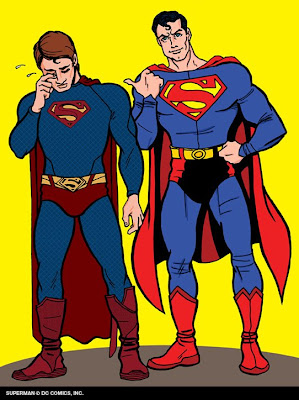 All those costumes in one film could be overwhelming for those who
can’t tell a Kree from a Skrull, so we thought we’d give you a primer on
who’ll be fighting for the best room in Avengers Mansion (yes, they
have a mansion).
All those costumes in one film could be overwhelming for those who
can’t tell a Kree from a Skrull, so we thought we’d give you a primer on
who’ll be fighting for the best room in Avengers Mansion (yes, they
have a mansion).CAPTAIN AMERICA (Chris Evans)
Cap’s solo film (currently filming under the direction of Joe Johnston) uses the comic’s World War II origin story
IRON MAN (Robert Downey Jr.)
Following two
WAR MACHINE (Don Cheadle)
Downey’s going to have some familiar faces on set… Don Cheadle is reprising his role as the ultra-weaponized Iron Man counterpart, War Machine, who, in the comics was a member of the West Coast Avengers
THE BLACK WIDOW (Scarlett Johansson)
Although never referred to as such, Black Widow was Scarlett Johansson’s character’s code-name in Iron Man 2. In the comics, the Russian counter-spy has slinked all around the Marvel universe, as an Agent of S.H.I.E.L.D.
HAWKEYE (Jeremy Renner)
Marvel Comics’ answer to DC’s Green Arrow, the master archer has been a minor character in the Marvel Universe since the 1960s, and a major player in the Avengers for most of its existence. The Hurt Locker’s Jeremy Renner seems like a glove-fit to play the brash bowman, currently the only major hero who’ll be introduced in The Avengers rather than his own film first. One thing seems certain, though… the character’s onscreen costume will probably bear little resemblance to the ridiculous purple suit he wears in the comics.
THOR (Chris Hemsworth) and LOKI (Tom Hiddleston)
The Asgardian Gods of Thunder and Mischief respectively, brothers Thor and Loki square off in next summer’s Kenneth Branagh epic, but with Hiddleston listed in the cast for the Avengers, perhaps by the end of Thor, they will have punched and made up (at least to form an uneasy alliance in The Avengers)? It’s more likely that Loki will take part in whatever massive evil requires a team of super powered heroes to conquer. In any case, how the movie balances the grit of Iron Man with the fantasy of Thor will be interesting to see.
THE HULK (Mark Ruffalo)
After Ang Lee’s overly introspective HULK and Louis Letterier’s video-gamey reboot, hopefully third time will be the charm for Marvel’s grumpy green giant. Mark Ruffalo takes over the role of Bruce Banner from the departing Edward Norton. Since the 2008 film established Banner’s transformation as a gone-wrong attempt at recreating Captain America’s super-soldier serum, we can assume that plot point will play in The Avengers. There is speculation that the impetus for the team’s initial formation is to capture (and recruit?) an out-of-control Hulk.
AGENT PHIL COULSON (Clark Gregg)
In addition to handling exposition, perhaps Coulson will do chores that the computer butler Jarvis cannot (in the comics, Tony Stark’s butler is a human who does double duty as major-domo to the Avengers).
NICK FURY (Samuel L. Jackson)
The glue holding together the cinematic Marvel Universe isn’t Stan Lee (although an Avengers cameo feels guaranteed), but Sam Jackson’s leader of the Strategic Homeland Intervention, Enforcement, and Logistics Division (S.H.I.E.L.D.). It’s been reported that in the film, Fury, and not Captain America will be the leader of the Avengers, which could lead to some conflict of styles and ideals perfectly suited to the angsty, clashing Marvel Universe.
At this point, the plot is a tightly guarded secret (The Infinity Gauntlet, a jewel-encrusted glove that grants the bearer control of the universe could come into play). The selection of Joss Whedon as director should please fanboys, as his Buffy the Vampire Slayer and Firefly showed he’s adept at balancing action and characterization.
So now it’s hurry up and wait. If both Captain America and Thor’s films turn out to be duds at the box office, that could put a serious damper on the excitement for The Avengers… with the mainstream audience, that is. As for the fanboys, nothing short of recasting David Hasselhoff as Nick Fury could keep them away.
___________________________________________________________
NOTE: This piece originally appeared on STARPULSE on August 8, 2010.







